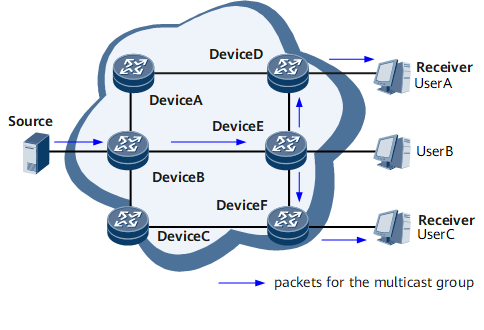Overview of IP Multicast Basics
Definition
IP multicast is a method of sending a single IP stream to multiple receivers simultaneously, reducing bandwidth consumption. IP multicast provides benefits for point to multi-point (P2MP) services, such as e-commerce, online conferencing, online auctions, video on demand, and e-learning. P2MP services offer opportunities for significant profits, yet require high bandwidth and secure operation. IP multicast is used to meet these requirements.
IP Addresses Identified by Hosts
Hosts identify the following types of IP addresses:
Unicast IP address
A unicast IP address can identify only one host, and a host can identify only one unicast IP address. An IP packet that carries a unicast destination address can be received by only one host.
Broadcast IP address
A broadcast IP address can identify all hosts on a network segment, and an IP packet that carries a broadcast destination IP address can be received by all hosts on a network segment. However, a host can identify only one broadcast IP address. IP broadcast packets cannot be transmitted across network segments.
Multicast IP address
A multicast IP address can identify multiple hosts at different locations, and a host can identify multiple multicast IP addresses. An IP packet that carries a multicast destination IP address can therefore be received by multiple hosts at different locations.
IP Transmission Modes
Based on the IP address types, networks can transmit packets in the following modes:
IP unicast mode
IP broadcast mode
IP multicast mode
Any of these modes can be used for P2MP data transmission.
Unicast transmission
Features: A unicast packet uses a unicast address as the destination address. If multiple receivers require the same packet from a source, the source sends an individual unicast packet to each receiver.
Disadvantages: This mode consumes unnecessary bandwidth and processor resources when sending the same packet to a large number of receivers. Additionally, the unicast transmission mode does not guarantee transmission quality when a large number of hosts exist.
Broadcast transmission
Features: A broadcast packet uses a broadcast address as the destination address. In this mode, a source sends only one copy of each packet to all hosts on the network segment, irrespective of whether a host requires the packet.
Disadvantages: This mode requires that the source and receivers reside on the same network segment. Because all hosts on the network segment receive packets sent by the source, this mode cannot guarantee information security or charging of services.
Multicast transmission
As shown in Figure 1, a source exists on the network. User A and User C require information from the source, while User B does not. The transmission mode is multicast.
Features: A multicast packet uses a multicast address as the destination address. If multiple receivers on a network segment require the same packet from a source, the source sends only one packet to the multicast address.
The multicast protocol deployed on the network establishes a routing tree for the packet. The tree's root is the source, and routes branch off to all multicast members. As shown in Figure 1, multicast data is transmitted along the path: Source → DeviceB → DeviceE [ →DeviceD → User A | → DeviceF → User C ].
Advantages: In multicast mode, a single information flow is sent to users along the distribution tree, and a maximum of one copy of the data flow exists on each link. Users who do not require the packet do not receive the packet, providing the basis for information security. Compared with unicast, multicast does not increase the network load when the number of users increases in the same multicast group. This advantage prevents the server and CPU from being overloaded. Compared with broadcast, multicast can transmit information across network segments and across long distances.
Multicast technologies therefore provide the ideal solution when one source must address multiple receivers with efficient P2MP data transmission.
Multicast applications: Multicast applies to all P2MP applications, such as multimedia presentations, streaming media, communications for training and tele-learning, highly reliable data storage, and finance (stock-trading) applications. IP multicast is being widely used in Internet services, such as online broadcast, network TV, distance learning, remote medicine, network TV broadcast, and real-time video and audio conferencing.
